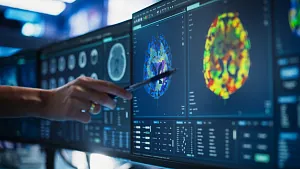
Revolutionary Breakthrough in Brain Science: Chinese Scientists Unveil Multicolour Imaging Technology
2025-08-26
Author: Wei Ling
A Groundbreaking Achievement in Neuroscience
In a jaw-dropping advancement, Chinese scientists have made history by performing the world's first high-resolution, multicolour deep-brain imaging in freely moving mice. This incredible achievement, powered by an ultra-light miniature two-photon microscope, promises to elevate neuroscience research to unprecedented heights.
Real-Time Observation of Neurons
According to reports from Xinhua News Agency, the new study introduces a revolutionary method for real-time observation of the complex activities of neurons and synapses. This addresses a long-standing challenge in understanding the brain's intricate workings.
Innovation Led by a Visionary
Under the leadership of Professor Cheng Heping from Peking University, the breakthrough builds upon foundational work from 2017. A pivotal innovation was the creation of an ultra-broadband hollow-core fibre, developed in partnership with Beijing Information Science and Technology University. This cutting-edge fibre transmits ultrafast laser pulses across a range of wavelengths, enabling groundbreaking multicolour imaging for the first time.
Lightweight Technology for Heavy Insights
Weighing in at just 2.6 grams, the revolutionary microscope was utilized in studies on mice suffering from Alzheimer's disease. It adeptly captured red, green, and blue signals that reveal neuronal activity, mitochondrial function, and the accumulation of plaque—key indicators in understanding this devastating condition. The researchers detected early abnormalities near plaque deposits, providing fresh insights into the progression of Alzheimer's.
Endless Possibilities Ahead
Professor Cheng highlighted that this groundbreaking innovation paves the way for new explorations into brain networks, disease mechanisms, drug testing, and the development of brain-computer interfaces. The future of neuroscience looks promising as these advances could lead to transformative discoveries in brain health and technology.

 Brasil (PT)
Brasil (PT)
 Canada (EN)
Canada (EN)
 Chile (ES)
Chile (ES)
 Česko (CS)
Česko (CS)
 대한민국 (KO)
대한민국 (KO)
 España (ES)
España (ES)
 France (FR)
France (FR)
 Hong Kong (EN)
Hong Kong (EN)
 Italia (IT)
Italia (IT)
 日本 (JA)
日本 (JA)
 Magyarország (HU)
Magyarország (HU)
 Norge (NO)
Norge (NO)
 Polska (PL)
Polska (PL)
 Schweiz (DE)
Schweiz (DE)
 Singapore (EN)
Singapore (EN)
 Sverige (SV)
Sverige (SV)
 Suomi (FI)
Suomi (FI)
 Türkiye (TR)
Türkiye (TR)
 الإمارات العربية المتحدة (AR)
الإمارات العربية المتحدة (AR)